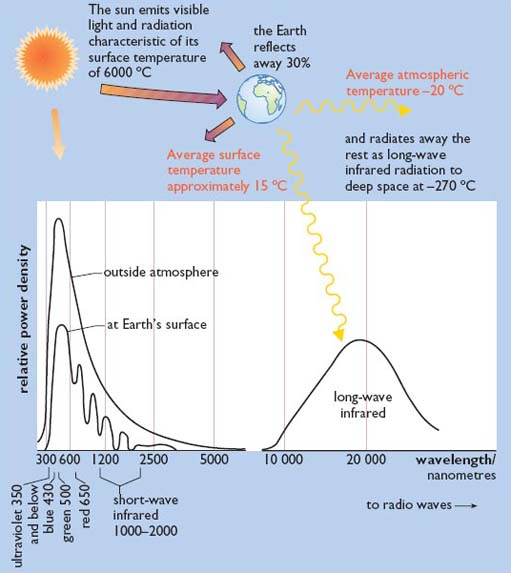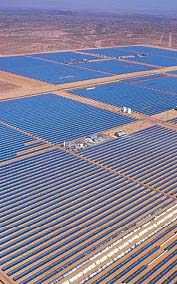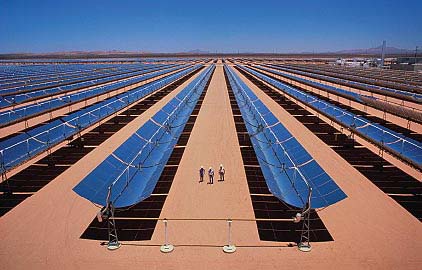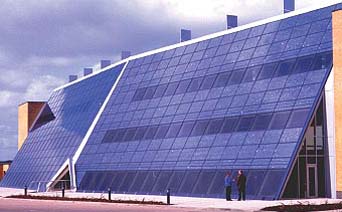4.1 Solar energy
Solar energy, it should firstly be stressed, makes an enormous but largely unrecorded contribution to our energy needs. It is the sun's radiant energy, as noted in Box 2, that maintains the Earth's surface at a temperature warm enough to support human life. But despite this enormous input of energy to our civilisation, the sun is virtually ignored in national and international energy statistics, which are almost entirely concerned with consumption of commercial fuels.

The sun has a surface temperature of 6000°C, maintained by continuous nuclear fusion reactions between hydrogen atoms within its interior. These nuclear reactions will gradually convert all of the hydrogen into heavier elements, but this is a relatively slow process and the sun should continue to supply power for another 5 billion years.
The sun radiates huge quantities of energy into the surrounding space, and the tiny fraction intercepted by the Earth's atmosphere, 150 million km away, is nonetheless equivalent to about 15,000 times humanity's present rate of use of fossil and nuclear fuels. Even though approximately one-third of the intercepted energy is reflected away by the atmosphere before reaching the earth's surface, this still means that a continuous and virtually inexhaustible flow of power amounting to 10,000 times our current rate of consumption of conventional fuels is available in principle to human civilisation.
Solar energy, when it enters our buildings, warms and illuminates them to a significant extent. When buildings are specifically designed to take full advantage of the sun's radiation, their needs for additional heating and for artificial lighting can be further reduced.
Solar power can also be harnessed by using solar collectors to produce hot water for washing or space heating in buildings.
Such collectors are in widespread use in sunny countries such as Israel and Greece, but are also quite widely used in less sunny places such as Austria. Even in cloudy Britain there are more than 40,000 roof-top solar water heating systems.

The roof of this solar house in Oxford has a grid-linked 4 kW array of photovoltaic panels. These generate enough electricity to supply its annual requirements, plus a surplus which is used to provide part of the power to run a small electric car. The roof also incorporates a 5 m2 array of solar water heating panels which provide three-quarters of the house's hot water requirements. The house is well-insulated and includes a conservatory that contributes 'passive' solar energy to space heating in Spring and Autumn, supplemented by a natural gas boiler and a small wood-burning stove used on very cold days.
In regions such as Southern California, where solar radiation levels are more than twice those of the UK and skies are clearer, the sun's rays are strong enough to make it practicable to generate high-temperature steam using arrays of concentrating mirrors. The steam can then be used to power a turbine that drives a generator to produce electricity (Figure 30).


Harnessing solar energy to provide electricity directly involves the use of a different and more sophisticated technology called solar photovoltaics (PV). Photovoltaic 'modules' are made of specially-prepared layers of semi-conducting materials (usually silicon) that generate electricity when photons of sunlight fall upon them. Arrays of PV modules are normally mounted on the roofs or facades of buildings, providing some or all of their electricity needs (Figures 29 and 31).
Photovoltaic technology is growing very rapidly and several countries have initiated major development and demonstration programmes. Germany, for example, plans to install 100,000 PV roofs and building facades by the end of 2003.

The 3500 m2 solar office building at the Doxford International Business Park near Sunderland in the UK incorporates 646 m2 of photovoltaic modules. These have a peak power output of 73 kW and generate some 55,000 kWh of electricity per year. The building is well insulated and uses passive solar design to maximise the use of natural daylight and to minimise space heating and air conditioning needs. It is also designed for natural ventilation and night-time cooling
Photovoltaics may well make a significant contribution to world needs in coming decades, but at present its share of world consumption is extremely small. This is mainly due to the very high cost of PV modules, which are currently produced in relatively small quantities. Studies have shown that if the annual output of the manufacturing plants that produce PV modules were increased by a factor of about 20, the cost of PV-generated electricity could be reduced to a point at which it would be competitive with electricity from conventional sources in many industrialised countries.
